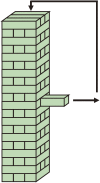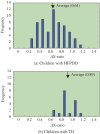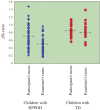Behavioral characteristics of children with high functioning pervasive developmental disorders during a game
- PMID: 20179365
- PMCID: PMC3920406
- DOI: 10.2188/jea.je20090178
Behavioral characteristics of children with high functioning pervasive developmental disorders during a game
Abstract
Background: To evaluate children's sociability through their behavior, we compared the motion features of children with high functioning pervasive developmental disorders (HFPDD) and typical development (TD) during a game. We selected 'Jenga' as the game because this is an interactive game played by two people.
Methods: We observed the behavior of 7 children with HFPDD and 10 children with TD. An optical motion capture system was used to follow the movement of 3-dimensional position markers attached to caps worn by the players.
Results: The range of head motion of the children with HFPDD was narrower than that of the control group, especially in the X-axis direction (perpendicular to the line connecting the two players). In each game, we calculated the range of motion in the X-axis of each child and divided that figure by the matched adult player's range. The average ratios of children with HFPDD and TD were 0.64 and 0.89 (number of games are 61 and 18), and the difference of these two ratios is significant (P < 0.001).
Conclusions: This ratio has sensitivity to identify HFPDD children and could be useful in their child care.
Figures







Similar articles
-
[A study of cognitive and behavioral development in pre-school and school children with high functioning pervasive developmental disorder].No To Hattatsu. 2009 Nov;41(6):420-5. No To Hattatsu. 2009. PMID: 19928539 Japanese.
-
High Prevalence of Non-psychotic Delusions in Children with High-functioning Pervasive Develonmental Disorder.Osaka City Med J. 2015 Dec;61(2):73-80. Osaka City Med J. 2015. PMID: 26995851
-
Moral judgment in high-functioning pervasive developmental disorders.Psychiatry Clin Neurosci. 2007 Aug;61(4):407-14. doi: 10.1111/j.1440-1819.2007.01678.x. Psychiatry Clin Neurosci. 2007. PMID: 17610666
-
Quality of life in mothers of preschoolers with high-functioning pervasive developmental disorders.Pediatr Int. 2015;57(1):149-54. doi: 10.1111/ped.12560. Pediatr Int. 2015. PMID: 25495867
-
The impact of recreational video game play on children's and adolescents' cognition.New Dir Child Adolesc Dev. 2013 Spring;2013(139):41-50. doi: 10.1002/cad.20030. New Dir Child Adolesc Dev. 2013. PMID: 23483692 Review.
Cited by
-
Interpersonal physiological synchrony is associated with first person and third person subjective assessments of excitement during cooperative joint tasks.Sci Rep. 2021 Jun 15;11(1):12543. doi: 10.1038/s41598-021-91831-x. Sci Rep. 2021. PMID: 34131193 Free PMC article.
-
NIRS-Based Hyperscanning Reveals Inter-brain Neural Synchronization during Cooperative Jenga Game with Face-to-Face Communication.Front Hum Neurosci. 2016 Mar 8;10:82. doi: 10.3389/fnhum.2016.00082. eCollection 2016. Front Hum Neurosci. 2016. PMID: 27014019 Free PMC article.
References
-
- Putallaz M Predicting children’s sociometric status from their behavior . Child Dev. 1983;54:1417–26 10.2307/1129804 - DOI
-
- Mehrabian A Communication without words . Psychol Today. 1968;2:52–5
Publication types
MeSH terms
LinkOut - more resources
Full Text Sources
Miscellaneous

